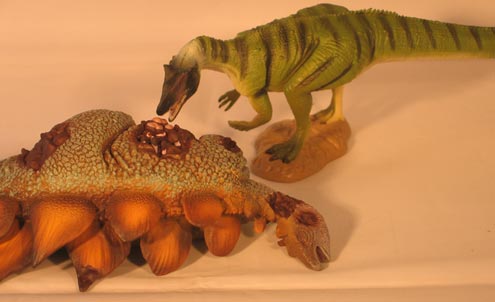Stegosaurus Corpse from CollectA in the Spotlight
The model making company called CollectA have recently added a replica of a dead Stegosaurus to their prehistoric animals model range. This is the second dinosaur corpse introduced by CollectA, the Stegosaurus following the Triceratops carcase that was added in 2012.
The CollectA Stegosaurus Corpse Dinosaur Model
Stegosaurus
Stegosaurus is one of the easiest to recognise dinosaurs with its rows of plates running along its back and the spikes on its tail. The Stegosauria is actually represented by a large number of different genera, these herbivorous dinosaurs probably first appeared in Asia, and then migrated to North America, Africa and into Europe. The type of stegosaur that most people are familiar with has the plate layout and spikes seen in this CollectA replica, representing a Stegosaurus from the Late Jurassic of the western United States.
Most model collectors and young dinosaur fans have several Stegosaurus models in their collections, however, the introduction of a stegosaur corpse will help model makers to create an authentic scene reflecting life in the Late Jurassic. This Stegosaurus has been attacked and killed by a large meat-eating dinosaur, potentially something like an Allosaurus or possibly another member of the allosaurid family called a Saurophaganax. Coincidently, both an Allosaurus and a Saurophaganax model are made by CollectA and available from Everything Dinosaur.
CollectA Stegosaurus Corpse and the CollectA Saurophaganax Dinosaur Model
Picture credit: Everything Dinosaur
CollectA Dead Stegosaurus
The Stegosaurus corpse measures 18 centimetres in length and although it is not part of a scale model series, it is designed to fit approximately to the scale of a number of Late Jurassic dinosaur models made by CollectA in the same figure range. The model is very well sculpted with lots of detail, we particularly appreciate the fine wrinkles and folds depicted as part of the skin texture.
If we focus on the topside of the model, for the moment, we can see that the body cavity has been opened exposing the ribs and parts of the intestinal tract. A nice touch from the artists at CollectA are the rivulets of partially congealed blood that can be seen on the lower portion of the belly.
Lots of Detail on the Stegosaurus Figure
Picture credit: Everything Dinosaur
There are deep wounds visible in the upper arm/shoulder area and also at the back of the thigh. These wounds are probably post-mortem, that is they occurred as the carcase was fed upon and they were not the result of any injuries from combat. The thigh bone along with the humerus and the scapula, the shoulder blades, supported large muscles and it is these fleshy areas along with organs such as the liver that were likely to have been consumed first by any predator.
CollectA Prehistoric Animal Models
To view the CollectA range of prehistoric animal models available from Everything Dinosaur: CollectA Prehistoric Life Models and Figures.
If we consider the underside of the model, we can see evidence of a bite on one of those famous back plates and there is a small bite mark on the tail. The most obvious flesh wound is a large wound at the top of the neck.
The design team at CollectA probably wanted to indicate that this was the fatal injury that brought this large herbivore down. Clearly from what we can see in this replica, the model makers have taken great care to depict the Stegosaurus corpse and to reflect the pathology seen in the model, to what may very probably have happened in a fight to the death between a stegosaur and a large, meat-eating theropod dinosaur.
A corpse such as this would have provided a large carnivore, an Allosaurus for example, with enough food to keep the animal going for several weeks. Without a better understanding of dinosaur metabolism, how long a single stegosaur corpse could have sustained a big meat-eater is open to speculation.
However, the carcase would have attracted a lot of scavengers and if this skeleton had been preserved as part of the fossil record, palaeontologists would probably have found gouge marks on the bones and evidence of feeding by smaller dinosaurs, perhaps even broken teeth in association with the stegosaur remains.
The model is beautifully painted. The stegosaur has a bluey/green body with a lighter underside and the plates and tail spikes are painted a combination of orange and brown. It is a skilfully crafted dinosaur replica.









Leave A Comment